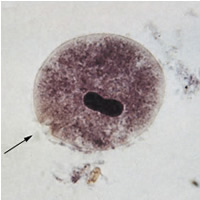Biology:Balantidium
| Balantidium | |
|---|---|

| |
| Balantidium coli trophozoite | |
| Scientific classification | |
| Domain: | Eukaryota |
| Clade: | Diaphoretickes |
| Clade: | SAR |
| Clade: | Alveolata |
| Phylum: | Ciliophora |
| Class: | Litostomatea |
| Order: | Vestibuliferida |
| Family: | Balantidiidae |
| Genus: | Balantidium Claparède & Lachmann, 1858[1] |
| Type species | |
| Balantidium entozoon[1] | |
| Synonyms | |
| |
Balantidium is a genus of ciliates. It contains the parasitic species Balantidium coli, the only known cause of balantidiasis.[2]
History
The first-described species of Balantidium, B. entozoon, was described in 1838 by Ehrenberg as a member of the genus Bursaria. Balantidium coli observed in patients with dysentery was originally described as Paramecium coli by Malmstein in 1857. In 1858, Edouard Claparède and Johannes Lachmann created the genus Balantidium and reclassified B. entozoon as its type species.[3] Stein in 1863, reclassified Paramecium coli into the genus Balantidium.
Transcriptomics
Transcriptome data for Balantidium ctenopharyngodoni, from single-cell transcriptome sequencing, were published in 2017 and were the first omics data within the subclass Trichostomatia.[4]
Taxonomy
A separate genus – Neobalantidium – has been created for several of these species.[5] Balantidium coli is one of the species that has been reclassified. It has also been proposed that it is a junior synonym of genus Balantioides–which has B. coli as the type species.[6]
The closest known relative of this genus is Buxtonella sulcata, a parasite of cattle.
Species
There are 72 species in the genus.[7]
References
- ↑ 1.0 1.1 Aescht, E. (2001) Denisia 01: Catalogue of the Generic Names of Ciliates (Protozoa, Ciliophora)
- ↑ "The Parasite: Balantidium coli". https://web.stanford.edu/group/parasites/ParaSites2003/Balantidium/Balantidium_coli_ParaSite.htm.
- ↑ Grim, J. Norman; Buonanno, Federico (2009). "A re-description of the ciliate genus and type species, Balantidium entozoon". European Journal of Protistology 45 (3): 174. doi:10.1016/j.ejop.2008.10.001. PMID 19251405.
- ↑ Sun, Zongyi; Jiang, Chuanqi; Feng, Jinmei; Yang, Wentao; Li, Ming; Miao, Wei (2017). "Phylogenomic analysis of Balantidium ctenopharyngodoni (Ciliophora, Litostomatea) based on single-cell transcriptome sequencing". Parasite 24: 43. doi:10.1051/parasite/2017043. PMID 29134943.
- ↑ Pomajbíková, K.; Oborník, M.; Horák, A.; Petrželková, K. J.; Grim, J. N.; Levecke, B.; Todd, A.; Mulama, M. et al. (28 March 2013). "Novel insights into the genetic diversity of Balantidium and Balantidium-like cyst-forming ciliates". PLOS Neglected Tropical Diseases 7 (3): e2140. doi:10.1371/journal.pntd.0002140. PMID 23556024.
- ↑ Chistyakova, L. V.; Kostygov, A. Y.; Kornilova, O. A.; Yurchenko, V. (4 September 2014). "Reisolation and redescription of Balantidium duodeni Stein, 1867 (Litostomatea, Trichostomatia)". Parasitology Research 113 (11): 4207–4215. doi:10.1007/s00436-014-4096-1. PMID 25185665. https://link.springer.com/article/10.1007/s00436-014-4096-1.
- ↑ Y. Roskov; L. Abucay; T. Orrell et al., eds. "Catalogue of Life - 2015 Annual Checklist". http://www.catalogueoflife.org/annual-checklist/2015/browse/tree/id/9e827ac5bd1a4e2a581974dd4a8977a2.
- ↑ Zhao, Weishan; Li, Can; Zhang, Dong; Wang, Runqiu; Zheng, Yingzhen; Zou, Hong; Li, Wenxiang; Wu, Shangong et al. (2018). "Balantidium grimi n. sp. (Ciliophora, Litostomatea), a new species inhabiting the rectum of the frog Quasipaa spinosa from Lishui, China". Parasite 25: 29. doi:10.1051/parasite/2018031. ISSN 1776-1042. PMID 29806591.
Wikidata ☰ Q15149810 entry
 |

